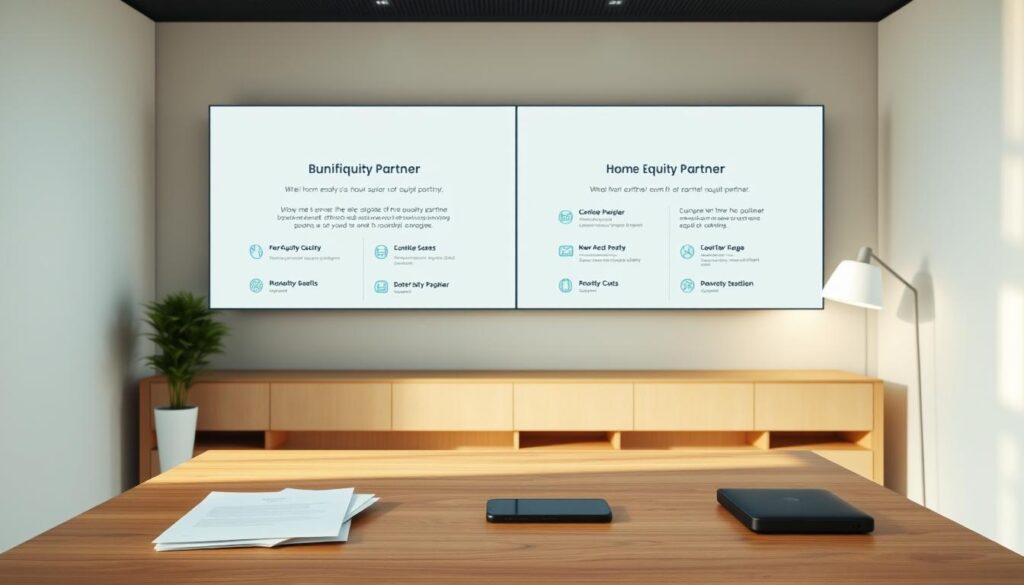Did you know U.S. homeowners currently hold $17.2 trillion in accessible home equity? That’s an average of $207,000 per household—a powerful financial resource waiting to be tapped. Unlike traditional loans, equity-based solutions let you leverage this asset without monthly payments or added debt.
Your property isn’t just a place to live—it’s a wealth-building tool. As real estate values rise, so does your stake. Strategic use of this growing equity can fund renovations, cover emergencies, or even finance new investments.
This guide explores smart ways to convert your property’s hidden value into opportunities. You’ll discover how to:
- Access funds without taking on high-interest debt
- Use improvements to boost your property’s market worth
- Preserve long-term wealth while meeting current needs
What Is Home Equity Sharing and How Does It Work?
Imagine unlocking cash from your property without monthly payments—that’s the power of equity sharing. Unlike loans, this co-ownership model lets you trade a portion of future appreciation for upfront funds. Think of it like selling stock in your house, as Unison’s CEO describes.
Understanding the Basics of Equity Agreements
An equity agreement gives investors a stake (typically 10%–30%) in your property’s future growth. If your home’s property value rises by $150,000, they’d earn $15,000 for a 10% share. If it drops, they share the loss—reducing your risk.
Terms usually span 10–30 years. Repayment happens when you sell, refinance, or the term ends. No monthly bills, just a lump sum later.
How Investors and Homeowners Benefit
For you, it’s immediate money for renovations, emergencies, or debt consolidation. Investors gain passive real estate exposure without landlord hassles. Both sides bet on long-term growth.
Example: A $50,000 advance for 15% of appreciation. Sell later for $100,000 more? You repay $65,000 total ($50k + 15% of gains). No prepayment penalties mean flexibility.
This investment model works best when you need cash now but expect steady property value growth over time.
Maximizing Home Value with Equity Sharing: Key Strategies
Your property’s worth isn’t just about today—it’s about smart moves for tomorrow. Equity sharing lets you tap into future gains now, but success hinges on two steps: picking the right partner and understanding risk adjustments.

Finding the Best Equity Partner
Providers like Unison, Point, and Hometap offer different terms. Their risk adjustments—a discount on your home’s appraised value—range from 2.75% to 20%. Here’s how they compare:
| Provider | Risk Adjustment | Term Length |
|---|---|---|
| Unison | 5% | 10–30 years |
| Point | 10–15% | 10 years |
| Hometap | 2.75–20% | 10 years |
Always get multiple quotes. A lower adjustment means more cash upfront for your *project*.
Calculating Your Home’s Adjusted Value
A $500,000 house might be valued at $450,000 after a 10% adjustment. But strategic *home improvements* can offset this. Kitchen remodels, for example, deliver a 94% ROI.
Here’s the math:
- Appraisal: $500,000 (costs ~$350)
- Risk adjustment: 10% → $450,000 usable value
- Post-renovation: $550,000 value → $495,000 adjusted
Treat your house as an investment. Small upgrades protect your *property value* and maximize returns when you sell.
Pros and Cons of Equity Sharing Agreements
Looking for cash without monthly bills? Equity sharing might be your answer. This unique model lets you tap into your property’s worth now—but it’s not without trade-offs. Below, we break down the key benefits and potential pitfalls.
Advantages: No Monthly Payments or Interest
Unlike a traditional loan, equity sharing requires zero monthly payments. You get funds upfront, and repayment happens only when you sell or refinance. No interest charges mean predictable long-term costs.
For example, Point’s $50K advance could grow to $72K in appreciation payments over a decade. Compare that to a 10% HELOC, where you’d pay $29K in interest alone.
Drawbacks: Long-Term Costs and Restrictions
While no monthly bills sound great, the lump-sum repayment can be steep. That same $50K might cost $122K after 10 years if your home’s value jumps. Origination fees (3–4.9%) also add to your costs.
| Option | Upfront Cost | 10-Year Repayment |
|---|---|---|
| Equity Sharing | $50K | $122K* |
| HELOC | $0 | $79K ($50K + $29K interest) |
*Assumes 7% annual home appreciation.
Other limitations include:
- State restrictions: Available in only 14–29 states.
- Buyout rules: Some providers limit when you can repurchase shares.
- Tax trade-offs: No deductions like with a mortgage or HELOC.
Still, home equity investments shine for owners who need cash fast and expect steady appreciation. Just weigh your options carefully.
Comparing Equity Sharing to Traditional Home Equity Loans
Choosing between financing options? Here’s how equity sharing stacks up against traditional loans. While both let you access cash, their costs and terms differ sharply. Your best option depends on income, timeline, and risk tolerance.
When Equity Sharing Outperforms HELOCs
HELOC rates currently hit 8.5–10%, while equity sharing charges 0% interest. This makes sharing ideal for:
- Fixed-income seniors: No monthly payments mean budget stability
- Long-term holders: Balloon payments align with eventual sales
- Renovation projects: 83% are funded via credit cards—sharing offers better terms
Providers like Unison cap advances at $600K, but their rate structure beats home equity loans for slow-repayment scenarios.
Scenarios Where Traditional Loans Win
HELOCs shine when you need:
| Feature | HELOC | Equity Sharing |
|---|---|---|
| Maximum amount | $1M+ | $600K |
| Tax deductions* | Yes (IRS Pub 936) | No |
| Flexible repayment | Draw periods | Lump-sum only |
*Interest may be deductible if used for home improvements. Equity gains aren’t.
Consider cash-out refinancing too—current interest rates make this competitive for some borrowers. NerdWallet shows Achieve at 5.0% vs Figure’s 4.0% for home equity loans.
Steps to Apply for a Home Equity Sharing Agreement
Ready to unlock your property’s potential? Here’s how to get started. The process blends speed with simplicity—often wrapping up in 3–6 weeks. You’ll need documents like pay stubs, tax returns, and proof of ownership.
Prequalification and Home Appraisal
First, providers check your address and pull a soft credit score (500+ minimum). If prequalified, a third-party home appraisal confirms your property’s value. This costs ~$350 and takes 1–2 days.
Your advance depends on loan-to-value (LTV) ratios—usually 70–85%. For example:
- $400K home with 30% equity → $280K max advance (70% LTV)
- After a 10% risk adjustment → $252K usable funds
Navigating Fees and Closing Costs
Watch for origination fees (3–4.9%) and hidden charges. Here’s how top providers compare:
| Provider | Origination Fee | Other Costs |
|---|---|---|
| Unison | 3% | Title insurance, notary fees |
| Unlock | 4.9% | State taxes, appraisal |
Pro tip: Renovate before appraisal. A $20K kitchen upgrade could boost your advance by $18K (90% ROI).
Final checklist:
- Proof of income (last 2 pay stubs)
- Mortgage statements
- Government-issued ID
Real-World Examples of Equity Sharing Success
Meet homeowners who turned their property’s hidden potential into real financial wins. These stories show how strategic equity use creates opportunities—from kitchen upgrades to debt relief. You’ll see actual numbers and learn what worked (and what didn’t).
From Dated Kitchen to $26K Value Boost
The Rodriguez family accessed $50,000 through an equity agreement. They invested $30,000 in a kitchen remodel with quartz counters and smart appliances. The upgrade added $26,400 to their property value—a 94% return.
Here’s the breakdown:
| Item | Cost | Value Added |
|---|---|---|
| Equity Advance | $50,000 | N/A |
| Remodel Costs | $30,000 | $26,400 |
| Net Position | $20,000 cash | +$26,400 equity |
When they sell home in 5 years, the investor gets 15% of appreciation. But the upgrades ensure higher profits for both parties.
Retirement Security Through Strategic Modifications
At 72, Martha used $40,000 from Unlock Technologies to install grab bars, a walk-in tub, and smart home features. These age-in-place improvements increased her safety while preserving money for healthcare costs.
Key benefits:
- No monthly payments on fixed Social Security income
- 7% projected property value increase from upgrades
- Ability to stay in her community longer
Compare this to HELOC risks: When James lost his job, his $1,200 monthly HELOC payments became unaffordable. The bank foreclosed within 18 months.
Medical Debt Relief Without Sacrificing Ownership
A Unlock customer cleared $28,000 in hospital bills using equity funds. The alternative? A personal loan at 11% interest would’ve cost $35,000 over 5 years.
Not all stories succeed. One homeowner sold just 2 years into a 10-year term, triggering a 10% early termination fee. This shows why timing matters in real estate deals.
Lessons from these examples:
- Renovations deliver the best investment returns
- Fixed-income homeowners benefit from payment flexibility
- Always plan for the full term of your agreement
Conclusion
With $207K in average home equity, your house can work for you. But tapping into this investment requires careful planning. Always consult a Certified Equity Sharing Advisor (CESA) to weigh your options.
Need funds now? Compare short-term cash solutions against long-term ownership goals. Tools like NerdWallet help analyze providers side by side.
Remember: Balloon payments can surprise you later. Protect your property’s value by understanding repayment terms fully. Your real estate is more than a roof—it’s a financial tool.
Source Links
- https://www.ml.com/articles/how-to-calculate-your-home-equity-and-why-it-matters.html
- https://www.renofi.com/renovation-loans/home-equity-loans-for-renovations/
- https://www.nerdwallet.com/article/mortgages/home-equity-explained-matters
- https://www.cbsnews.com/news/is-a-home-equity-sharing-agreement-a-good-idea-heres-what-experts-say/
- https://point.com/hei/how-hei-works
- https://communitybank.net/how-to-maximize-your-home-equity-in-a-shifting-market/
- https://innago.com/navigating-equity-in-real-estate-investments/
- https://money.com/home-equity-sharing-pros-cons/
- https://www.truehold.com/post/home-equity-agreements
- https://www.consumerfinance.gov/data-research/research-reports/issue-spotlight-home-equity-contracts-market-overview/
- https://www.truehold.com/post/loan-free-home-equity-solutions
- https://www.cnbc.com/select/what-is-home-equity-sharing/
- https://www.bankrate.com/home-equity/what-is-home-equity/
- https://www.investopedia.com/terms/s/sweatequity.asp
- https://www.bankrate.com/home-equity/ways-to-increase-your-homes-value/
- https://www.sellinglater.com/blog/don’t-be-fooled-the-hidden-costs-of-home-equity-sharing-agreements
- https://point.com/blog/are-home-equity-investments-worth-it



